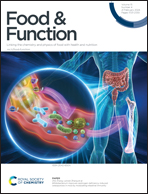Effects of an Akt-activating peptide obtained from walnut protein degradation on the prevention of memory impairment in mice†
Abstract
Akt acts as a central protein influencing multiple pathologies in neurodegenerative diseases including AD and PD, and using Akt activators is a promising management strategy. The current study characterized the effects of an Akt-activating peptide (Glu-Pro-Glu-Val-Leu-Pro, EPEVLR) obtained from walnut protein degradation on D-gal-induced memory impairment in mice. EPEVLR was obtained by hydrolysis of walnut proteins, identification of peptide sequences, and screening for molecular docking sequentially. The MWM test in mice indicated that the oral administration of EPEVLR (80, 200 and 400 mg per kg per day) significantly (p < 0.05) reversed D-gal-induced memory impairment. WB tests of the mouse hippocampus confirmed that EPEVLR could activate Akt by promoting its phosphorylation. In addition, further characterization (including TEM, ELISA, and immunohistochemistry) related to Akt phosphorylation showed lower Aβ and p-tau levels, as well as more autophagosomes than those in the model group. Moreover, the EPEVLR treatment significantly increased Lactobacillus abundance and reduced Helicobacter abundance in the gut microbiome and caused up-regulation of SCFAs and down-regulation of LPS of serum metabolites. Therefore, EPEVLR ingestion reversed cognitive impairment symptoms, possibly related to the activation of Akt and regulation of the intestinal flora pathway. Consumption of an EPEVLR-containing diet is beneficial for treating cognitive dysfunction.



 Please wait while we load your content...
Please wait while we load your content...